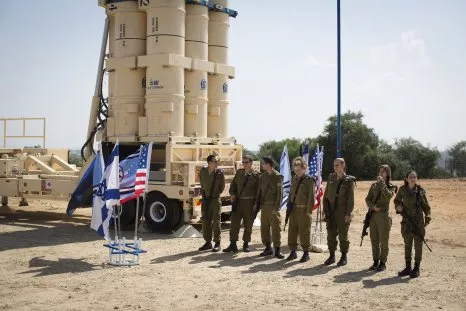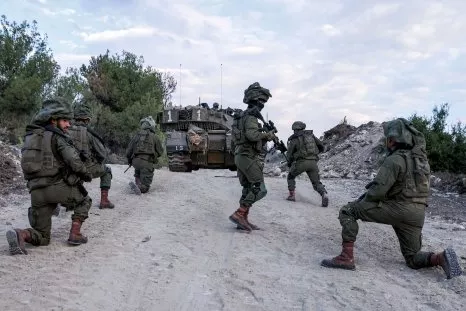What We Know About Hamas' Huge Rocket Arsenal
The military wing of the Palestinian Hamas movement has debuted a new torpedo, said to have been used for the first time in combat against the Israel Defense Forces (IDF) as war continues to consume the Gaza Strip.
It's only the latest addition, however, in a large, diverse and expanding arsenal of weapons that the group has used against Israel throughout a decades-long conflict.
Since being formed amid the First Intifada uprising against Israel in the 1980s and later taking control of Gaza in 2007, Hamas has managed to amass these weapons in spite of the IDF's longstanding attempts to institute a blockade of the coastal Palestinian territory. Israel and the United States have long accused Iran of helping Hamas' military force, the Al-Qassam Brigades, acquire such weapons, and Hamas officials have openly praised the Islamic Republic for its assistance, though the group has first and foremost credited indigenous ingenuity for acquiring such a stockpile.
The new torpedo, which first emerged in reports back in 2021, was previewed Monday by Al-Qassam Brigades spokesperson Abu Obaida during a 10-minute address in which he lauded his force's ongoing resistance against an escalating IDF campaign following Hamas' unprecedented October 7 attack on Israel.
Called "Al-Asef" or "the Storm" in Arabic, the torpedo was later showcased in a short promotional video that appeared to show Al-Qassam Brigades divers dragging the projectile across the shore into the sea before cutting to the weapon firing through the water.
A follow-up clip claimed to show the actual combat use of the Al-Asef, which was adorned with the words "Battle of Al-Aqsa Flood" after the ongoing operation launched earlier this month, along with the date October 30, 2023. The partially censored footage showed men in plain clothes configuring the torpedo in an undisclosed room and later dragging it into the ocean.
While Hamas has previously demonstrated limited naval capabilities, including at least one naval landing at the southern Israel kibbutz of Zikim during the October 7 surprise attack, rockets have long been the signature weapon of the group.
Fabian Hinz, a research fellow specializing in defense and military analysis at the International Institute for Strategic Studies, shared with Newsweek a list of known rockets in Hamas' possession, including those domestically produced with foreign assistance and others acquired from abroad.
On the shorter-range side in the domestically produced category is a weapon that takes its name after the same man that inspired the Al-Qassam Brigades' title. Also called Qassam as an ode to Syrian Muslim preacher Izz ad-Din al-Qassam whose clashes with British colonial authorities in Mandatory Palestine helped inspire a late 1930s Arab revolt, the Q-12 and Q-20 rockets have an estimated range of 12 kilometers and 20 kilometers, respectively.
The Qassam line of rockets, which first emerged in the early 2000s with particularly limited ranges, have been a mainstay of Hamas' attacks against Israel.
As with most of Hamas' ostensibly domestically assembled arsenal, the S-40 rocket is also designated after its range, which is estimated to be 40 kilometers, and was used in 2019 to target Jewish settlements near the Gaza Strip as well as the Israeli cities of Ashkelon, Ashdod and Beersheba, according to a Sky News Arabic report published earlier this month. The Sajjeel-55, with a range of 55 kilometers, was reportedly seen even earlier during the third major Gaza war in 2014.
That conflict, called "Operation Protective Edge" by Israel, was previously the deadliest of several conflicts fought between Hamas and the IDF since the latter's disengagement from the Gaza Strip in 2005 and the group's takeover of the territory two years later. It was sparked by clashes that erupted in the wake of Hamas' abduction and killing of three Israeli teenagers in the West Bank, which is under the control of the rival Fatah-led Palestinian National Authority.
The war came just two years after Israel launched the eight-day "Operation Pillar of Defense" in Gaza in 2012 after Hamas retaliated with rocket fire to the IDF's killing of Al-Qassam Brigades second-in-command Ahmed al-Jabari. During this flare-up, Hamas used the M-75 rocket, named after senior Hamas official Ibrahim al-Makadmeh who was killed by Israel in 2003. This put Tel Aviv in range, as did the J-80 and J-90 rockets, both named after Jabari.
With a range of 85 kilometers, the SH-85, is also believed to be named after another Al-Qassam Brigades subcommander, Mohammed Abu Shamala, who was killed during the 2014 Gaza war. Also slain during that conflict was senior Hamas official, Ra'ed al-Attar, whose name would be lent to the A-120 rocket first used to strike Jerusalem during 2021 clashes between Hamas and the IDF.
The A-120 bears a resemblance to the even further-range R-160, which debuted during the 2014 war and takes its name from Hamas official Abdel-Aziz Rantissi, who was killed in an Israeli airstrike a decade earlier. The Al-Qassam Brigades has more recently used the R-160 to strike Israel's northern city of Haifa during the current conflict.
The longest-range weapon known to exist in Hamas' stockpile, however, is the Ayyash-250, named after Yahya Ayyash, also known as "the Engineer," who pioneered the Al-Qassam Brigades' bombmaking efforts until his assassination by Israeli Shin Bet agents using an exploding cell phone in 1996. The Al-Qassam Brigades has shown footage of the Ayyash-250 conducting long-range strikes amid the ongoing war.
In addition to these weapons, Hamas is also believed to possess a number of rockets acquired from abroad. These include 107mm rockets acquired with an 8-kilometer range acquired from Iran, 122mm rockets with 12-40-kilometer ranges acquired from various countries, the Fajr-5 rocket with a 75-kilometer range acquired from Iran and the M302 rocket acquired with a 180-kilometer range acquired from Syria.
While these weapons remain a threat to the IDF, Hinz told Newsweek that, "if you look at what's being fired now, it almost all seems to be locally made." That's because foreign assets tend to be larger, less wieldy and more difficult to smuggle into the tightly controlled borders of Gaza, he said.
Hinz said the full degree of Hamas' smuggling networks are still not entirely known, but that they extend all the way to Iran, Iraq and Syria and across the waters of the Mediterranean into Libya, Sudan and Egypt, which borders Gaza and its intricate network of underground tunnels. Documentaries over the years have shown the group purporting to assemble parts from water pipes, old grenades from World War I shipwrecks and even ammonium chloride smuggled through Israel itself.
Further highlighting Iran's role, Hinz pointed to apparent intelligence leaks that appear to show the work of the Islamic Revolutionary Guard Corps Quds Force Unit 340, including Persian-language blueprints and motor tests of relatively unsophisticated rocket technology that would be far more suited for Hamas' efforts than those of the Islamic Republic's armed forces. Iranian officials have also frequently acknowledged that they provided Hamas with more than just rhetorical support, though they have said Tehran played no role in planning the October 7 assault.
Such rockets have been primarily used to target Israeli cities and military positions outside of Gaza, but Hinz said Hamas' stockpile could also prove beneficial in confronting a deepening IDF incursion into the Palestinian territory itself, especially by targeting "large staging areas" of Israeli troops. One particularly devastating weapon could be the use of improvised rocket assisted munitions (IRAMs) that utilize small rockets with large warheads, trading accuracy for impact.
Through both foreign assistance and homegrown skills, Hamas has managed to develop "a pretty diverse arsenal," according to Hinz.
"It's still very simple technologically," Hinz said. "We haven't seen anything with guidance, so they're technically rockets and not missiles, which is a bit surprising. Perhaps they're keeping some stuff in the background, which will only be revealed later. We'll see."
Responding to Newsweek's question during a press briefing Tuesday, IDF Lieutenant Colonel Jonathan Conricus said that "we understand that Hamas continues its efforts to acquire new and to enhance additional capabilities."
"We understand that they will try to deliver surprises on the battlefield," he added. "We know that they have had access to advanced weaponry, and we are taking active countermeasures against it in all dimensions, air, land, sea, cyber, all of the domains."
Disclaimer: The copyright of this article belongs to the original author. Reposting this article is solely for the purpose of information dissemination and does not constitute any investment advice. If there is any infringement, please contact us immediately. We will make corrections or deletions as necessary. Thank you.




